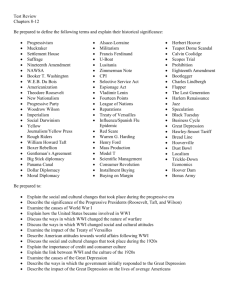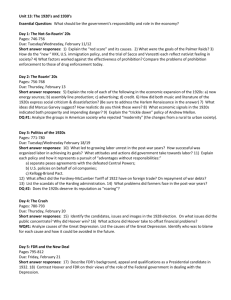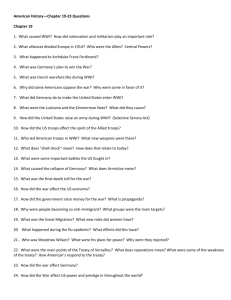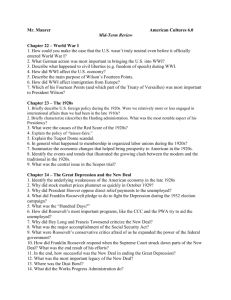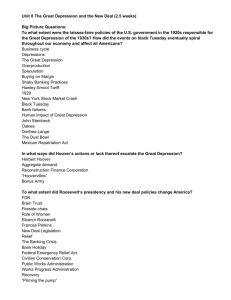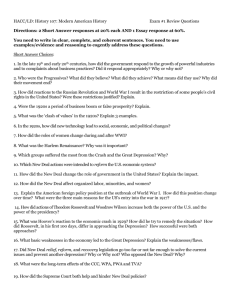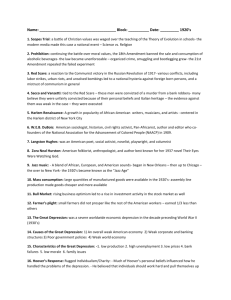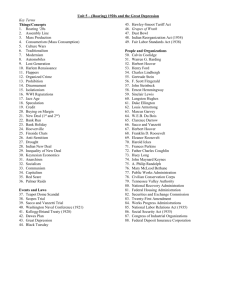Unit 5 Organizer
advertisement
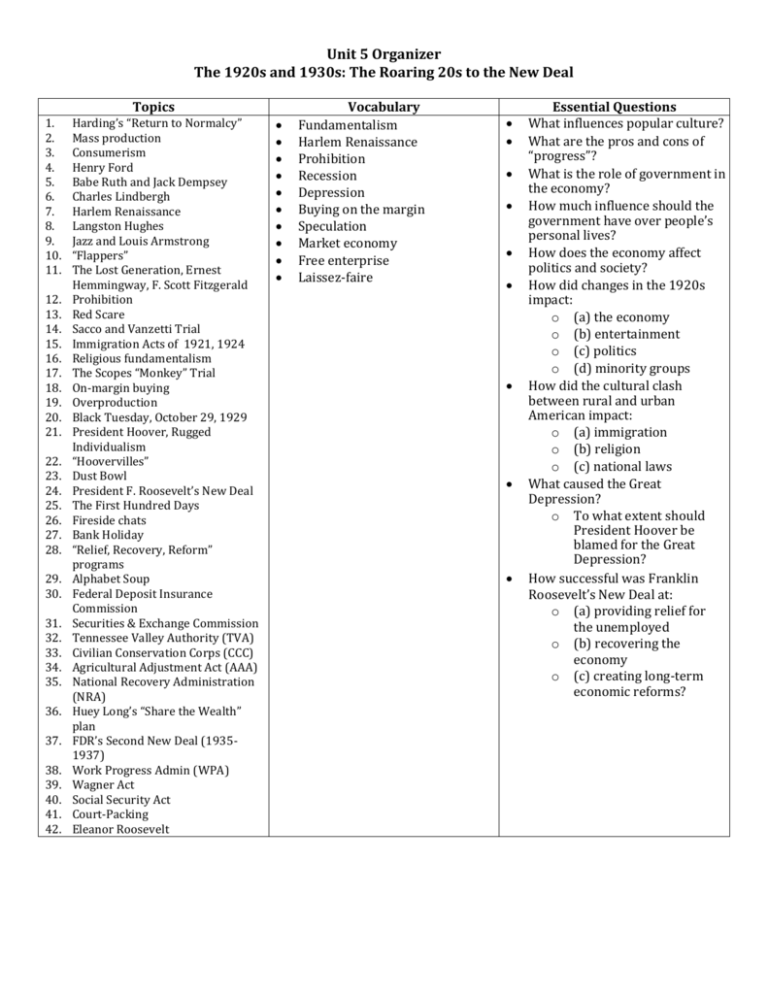
Unit 5 Organizer The 1920s and 1930s: The Roaring 20s to the New Deal Topics 1. 2. 3. 4. 5. 6. 7. 8. 9. 10. 11. 12. 13. 14. 15. 16. 17. 18. 19. 20. 21. 22. 23. 24. 25. 26. 27. 28. 29. 30. 31. 32. 33. 34. 35. 36. 37. 38. 39. 40. 41. 42. Harding’s “Return to Normalcy” Mass production Consumerism Henry Ford Babe Ruth and Jack Dempsey Charles Lindbergh Harlem Renaissance Langston Hughes Jazz and Louis Armstrong “Flappers” The Lost Generation, Ernest Hemmingway, F. Scott Fitzgerald Prohibition Red Scare Sacco and Vanzetti Trial Immigration Acts of 1921, 1924 Religious fundamentalism The Scopes “Monkey” Trial On-margin buying Overproduction Black Tuesday, October 29, 1929 President Hoover, Rugged Individualism “Hoovervilles” Dust Bowl President F. Roosevelt’s New Deal The First Hundred Days Fireside chats Bank Holiday “Relief, Recovery, Reform” programs Alphabet Soup Federal Deposit Insurance Commission Securities & Exchange Commission Tennessee Valley Authority (TVA) Civilian Conservation Corps (CCC) Agricultural Adjustment Act (AAA) National Recovery Administration (NRA) Huey Long’s “Share the Wealth” plan FDR’s Second New Deal (19351937) Work Progress Admin (WPA) Wagner Act Social Security Act Court-Packing Eleanor Roosevelt Vocabulary Fundamentalism Harlem Renaissance Prohibition Recession Depression Buying on the margin Speculation Market economy Free enterprise Laissez-faire Essential Questions What influences popular culture? What are the pros and cons of “progress”? What is the role of government in the economy? How much influence should the government have over people’s personal lives? How does the economy affect politics and society? How did changes in the 1920s impact: o (a) the economy o (b) entertainment o (c) politics o (d) minority groups How did the cultural clash between rural and urban American impact: o (a) immigration o (b) religion o (c) national laws What caused the Great Depression? o To what extent should President Hoover be blamed for the Great Depression? How successful was Franklin Roosevelt’s New Deal at: o (a) providing relief for the unemployed o (b) recovering the economy o (c) creating long-term economic reforms? Turning Points Movement Conflict and Compromise Freedom, Equality, 1. How was the stock market crash a turning point in American history? 2. Was the creation of the New Deal a turning point? 1. How did the US Presidents and their administrations developed and implemented imperials foreign policy strategies? 2. How did the economic circumstances of the Great Depression influence patterns of migration and settlement? 3. How did the onset of the Dust Bowl influence the displacement and migration of “Okies” during the Great Depression? 4. Why and how did various national, cultural, and ethnic groups decide to immigrate to the US? 5. How did the Immigration Quota Act of 1924 affect specific groups of immigrants? Political Issues: Analyze the political issues and conflicts that impacted the U.S. 1. How and why did eugenics become a political movement in several states at the beginning of the 20th Century? How did the movement impact various groups? 2. How did the administration of Harding, Coolidge, and Hoover revert to conservative government practices based on lower taxes and deregulation of industries? 3. How did Herbert Hoover become a scapegoat for what ailed the economy at the beginning of the Great Depression? Why did his “rugged individualism” failed to work? 4. How did Franklin D. Roosevelt deliver a “New Deal” to the American people that aimed to ease the effects of the depression through government programs and agencies that provided direct government relief, recovery, and reform? 5. Why were the New Deal programs opposed by the U.S. Supreme Court, Huey Long, Francis Townshend, and Charles Coughlin? 6. To what extent did the New Deal fundamentally change the nation’s political and economic systems. 7. How and to what extent did domestic programs proposed by Democratic presidents after FDR extended the relief, recovery, and reform efforts of the New Deal (Fair Deal, New Frontier, and Great Society)? Economic Issues: Analyze the economic issues and conflicts that impacted the U.S. 8. How did rampant speculation in the stock market led to the “Black Tuesday” crash of October 29, 1929? What were the global impacts of the crash? 9. Why did the Great Depression occur in the U.S.? To what extent did it affect the livelihood and fortunes of various Americans? 10. To what extent did FDR’s New Deal ease the economic effects of the depression through direct government relief, recovery efforts, and reform? 11. To what extent did a consumer based economy flourish in the 1920s? Social Issues: Analyze the social and religious conflicts, movements, and reforms that impacted the U.S. 12. How did the eugenics movement affect several groups of Americans during the 20th Century? 13. How did prohibition become “the law of the land” and why was it later repealed? Cultural Conflicts: Analyze the cultural conflicts that impacted the U.S. 14. How did “modernism” develop and challenged conventional and traditional practices of American society during the 1920? (jazz, flappers, the Harlem Renaissance, Negro nationalism, Charles Darwin, and Albert Einstein) 15. In what ways did defenders of tradition react to modern thought and rapid change in American society of the 1920s? (nativism, Sacco and Vanzetti case, rise of fundamentalism, Scopes Monkey Trial, Ku Klux, Klan, Prohibition, eugenics) 16. How did American culture continue to flourish during the Great Depression? 1. How did the Harlem Renaissance raise awareness of issues affecting the lives of African Americans in the 1920s through various forms of expression such as literature, art, and Power 2. Foreign Policy War 1. 2. 1. 2. 3. 4. 5. Progress, Crisis, and “American Dream” 1. 2. 3. 4. 5. music, and drama? Why did FDR attempt to “pack” the U.S. Supreme Court and how did the attempt affect the New Deal and the balance of power between the executive and judicial branches of government? How did international trade policies and tariffs such as the Hawley-Smooth Tariff shape the economic development and foreign policy of the U.S.? Why did American foreign policy shift to isolationism after WWI? Why did Allied countries of WWI reject Wilson’s Fourteen Points? How does this affect U.S. politics between world wars? How did labor unrest and strikes during and after U.S. involvement in WWI impact the economy and society? How, why and to what extent did the consumer based economy of the US flourish in the decades following WWI? How, why and to what extent did consumerism and materialism impact American society following WWI? How, why, and to what extent did Americans fear the spread of communism after WWI? How did that fear impact American culture? How did the birth of the automobile industry impact the economic and cultural development of the U.S? How did the invention and use of the radio impact the economic, political, and cultural development of the U.S? How did the onset of the Dust Bowl influence the displacement and migration of people during the Great Depression? How did the “Lost Generation” of American writers express the cultural struggle between modernism and tradition during the 1920s? (Hemingway, Fitzgerald, Wolfe, Faulkner) How did the people who lived during the Great Depression reflect on the conditions and turmoil of the era (Such As Us, The Grapes of Wrath, Native Son, Hard Times)
